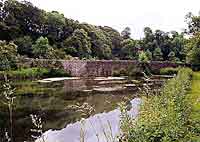River Lathkill in Derbyshire
See also Lathkill Dale
The river Lathkill must be one of Derbyshire's smallest rivers, but its interest and beauty easily make it one of the most impressive and a very popular tourist destination in Derbysdhire and the Peak District National Park. Much of the valley is part of the Derbyshire Dales National Nature Reserve and includes a Scheduled Ancient Monument, designated for its lead mine remains.
The upper reach of the river is a Site of Special Scientific Interest and a candidate Special Area of Conservation under the European Union Habitats Directive.
The river Lathkill and its dale can be accessed from several points along its stretch, but it is from the ancient lead mining village of Monyash across a hilly pasture that the top of the Lathkill ravine is reached. A narrow gap between towering walls of limestone where the floor is littered with rocks shattered by winter frosts, leads down into a narrow gully. The way opens out a little and opposite is a low cave under the cliff from which the old watercourse emerges, although in drier times the first springs are lower down.

Conksbury bridge |

River lathkill |
The bed of the stream is thick with weed down to where Cales Dale comes in from the right. Here the trees begin and the right hand side slopes of the valley are densely wooded, while on the opposite side the white rock is weathered into strange shapes. Soon the course clears and the river flows briskly over a stony bed. The Lathkill now stretches ahead, a fine sheet of water with limestone cliffs on either side. If the deserted upper stretches are wild and abandoned, the lower reaches are friendly and full of tranquil beauty, the haunt of dippers and water voles.
Unlike the pasture and silage fields of the plateau, the grassland of the dale is ablaze with wild flowers. The south facing slopes sparkle with rockrose and trefoil, which attract blue butterflies and burnet and forester moths. The shaded herbage of the north-facing slopes is the habitat for one of the dales specialities, Jacobs Ladder. Following the well worn footpath towards Over Haddon, grassland gives way to scrub and to ash woodland which is full of birdsong.
At Conksbury bridge the road from Youlgrave to Bakewell snakes across the river in a fine S bend, crossing by a low arched bridge. The river flows on through peaceful meadows to Alport where it meets the river Bradford and then towards its union with the Wye near Rowsley.
Lathkill Dale may look untouched but there is a long history of lead mining in the valley, and oral accounts suggest that the river was heavily regulated in the nineteenth century. The measures included lining the bed with puddled clay to prevent loss of flow into a lead mine drainage sough that runs beneath the valley floor. It is commonly assumed that the cause of the river drying for variable periods and lengths each year is lack of maintenance of the bed and banks and consequent loss of water to the sough. The shafts, drainage channels and spoil heaps have been absorbed into the natural landscape to such an extent that they realy enhance its natural beauty. Most of the lead had been exhausted by the 18th century but in the 1840`s there was an attempt to drain the deep mines by building a steam engine, powered by a huge waterwheel, fed by Mandale viaduct. The scheme was a disaster, as was the Over Haddon gold rush of 1894.
Other Derbyshire Rivers
River Bradford
River Derwent
River Dove
River Manifold
River Trent
River Wye
Derwent Valley Reservoirs